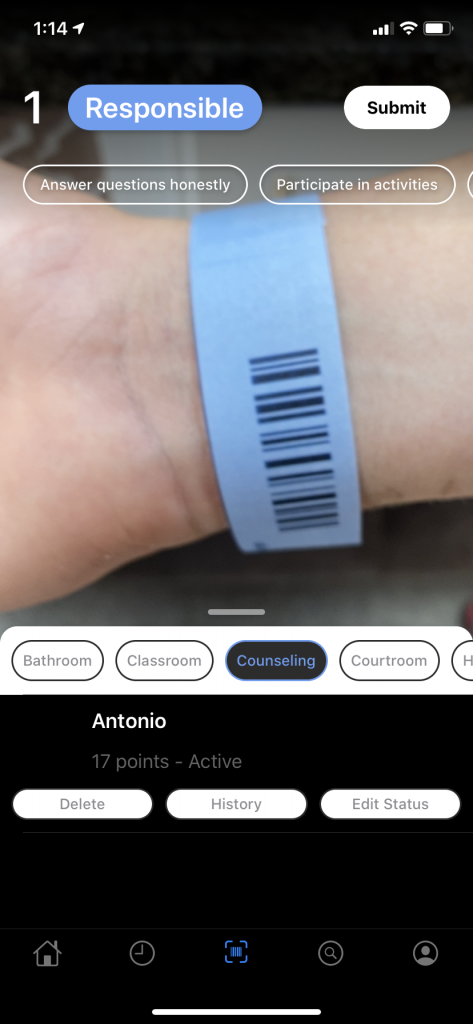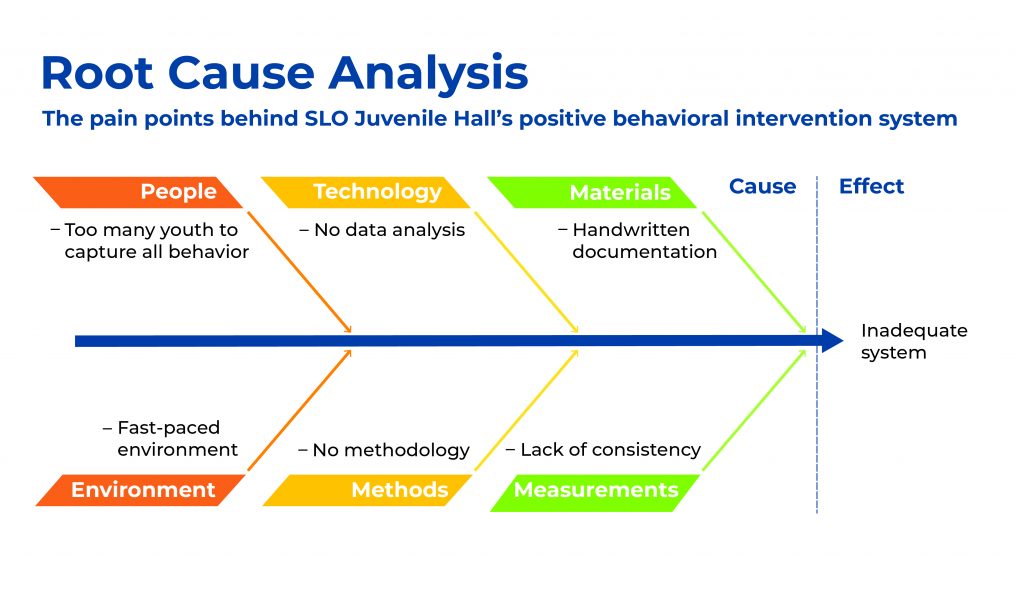Implementing Best Practices in Near-Realtime at the San Luis Obispo County Juvenile Hall

Overview
 In the PBIS program, the staff is trained to recognize hundreds of positive behaviors like kindness toward others and emotional self-control, then individuals are rewarded when they exhibit these behaviors. Posters listing safe, responsible, and considerate actions are posted around the facility so that youth can understand the expectations and ensure a fair and consistent approach. Positive actions are rewarded with verbal recognition and points, and youth can use those points to buy items like favorite snacks and hygiene products from the commissary.
In the PBIS program, the staff is trained to recognize hundreds of positive behaviors like kindness toward others and emotional self-control, then individuals are rewarded when they exhibit these behaviors. Posters listing safe, responsible, and considerate actions are posted around the facility so that youth can understand the expectations and ensure a fair and consistent approach. Positive actions are rewarded with verbal recognition and points, and youth can use those points to buy items like favorite snacks and hygiene products from the commissary.
Problem
The challenge is that the current approach used to track positive behavior is paper-based with handwritten codes and identities that significantly limits the program’s potential. The manual process results in inconsistent and slow enforcement that prevents youth from knowing how they are doing. It also prohibits data from being compared easily to other data collected at the facility. Without consistent, up-to-date information, it’s difficult to compile and analyze behavioral data to determine how well PBIS works.
Approach
The Juvenile Hall staff tried using handheld scanners to scan barcodes on bracelets. However, the scanners weren’t connected to the cloud, and each device had to have its data downloaded to a single desktop computer. Since the information wasn’t consistently collected, it wasn’t current. Eventually, the staff went back to the paper method.
Having struggled with ways to collect positive behaviors for each of the youth, it became clear that they needed a near-realtime solution in which the data could quickly be reflected back to the youth to reinforce positive behavior as it happened.
To find a better answer, the Juvenile Hall team approached California Polytechnic State University’s Digital Transformation Hub (DxHub) powered by Amazon Web Services. The team participated in the DxHub’s innovation process, utilizing the Amazon Working Backwards methodology. The group concluded that they needed a more sophisticated digital method to collect and process data.
Technical Solution
Using readily available mobile devices connected to the cloud, the DxHub team designed and demonstrated a mobile application that uses a cellphone camera to scan barcodes on bracelets. The system communicates to cloud resources using the Amazon API Gateway and AWS Amplify to call services and build them as needed. The mobile application makes it easy to scan an individual or a group. A tone confirms that the information is recorded. Since the data is stored in a central location using the Amazon Relational Database Service, it’s easily communicated back to the youth using the React Framework. All of the backend logic is powered by AWS Lambda, so that application can request or send information about a particular individual. There’s also an offline mode for areas in the facility that don’t have a strong wifi signal. The mobile device records and stores data until it senses a wifi signal and then automatically uploads the data.

Conclusion
The San Luis Obispo County Juvenile Hall is evaluating this new system in 2020. With faster and more accurate data collection, staff will be able to check an individual’s profile to see the rewards they’ve received and review point accumulation. Youth will also be able to see their progress and compare it to their peers anonymously. Since data will be in a single location, the leadership team will be able to use the information to monitor and evaluate the effectiveness of the Positive Behavioral Interventions and Supports program. Based on previous PBIS studies, Juvenile Hall officials expect to see a decrease in the need to use force and an increase in positive youth behavior, staff morale, and operational consistency.
“The Cal Poly DxHub was able to make a seemingly unattainable vision a tangible product. Through many different meetings, the team patiently worked with us, took our ideas—even those ideas that bordered on grandiose—and etched them into a very practical, real, and efficient product. We needed a team of experts to take our layman version of industrial technology coupled with our grandiose vision and mold it into a finished product that would work. The DxHub team was very patient, organized, and incredibly eager to help us. That and their consistently positive attitudes made the time dedicated to making the finished product enjoyable. They made me feel comfortable, and their ‘think big’ approach also aided in making this all possible. My sincere thanks and appreciation to Nick, Darren and their team for what they were able to produce and bring to our facility.”
— C. Todd Paramore, Supervising Deputy Probation Officer at Juvenile Hall
Supporting Documents
| Press Release & Frequently Asked Questions | During the Innovation Workshop, a fictional Press Release and nonfictional Frequently Asked Questions are drafted. This is a tool that is used to define the solution and why it matters to the customer. |
| Storyboard | A series of frames designed to illustrate the problem and the impact of the solution visually. |
| Source Code | Source code of the iOS wristband scanner as well as the backend React application and related CloudFormation templates of the AWS infrastructure. |
About the DxHub
Cal Poly’s Digital Transformation Hub (DxHub) was one of the earliest collaborations between Amazon Web Services (AWS) and an educational institution focused on innovation and digital transformation. While providing students with real-world learning experiences, the DxHub applies proven innovation methodologies in combination with the deep subject matter expertise of the public sector and the technical expertise of AWS to solve challenging problems in ways not contemplated before. For more information, visit dxhub.calpoly.edu.

